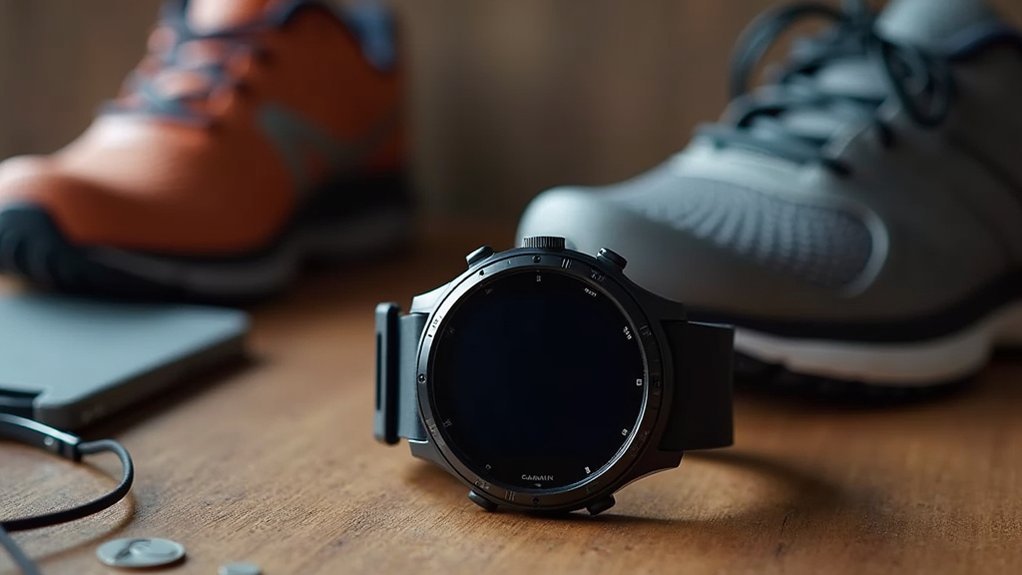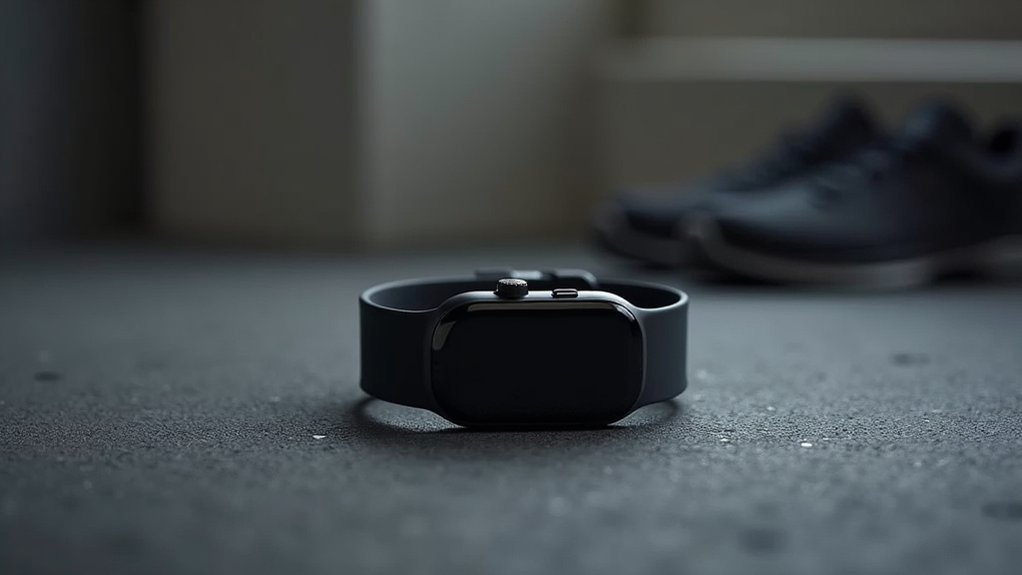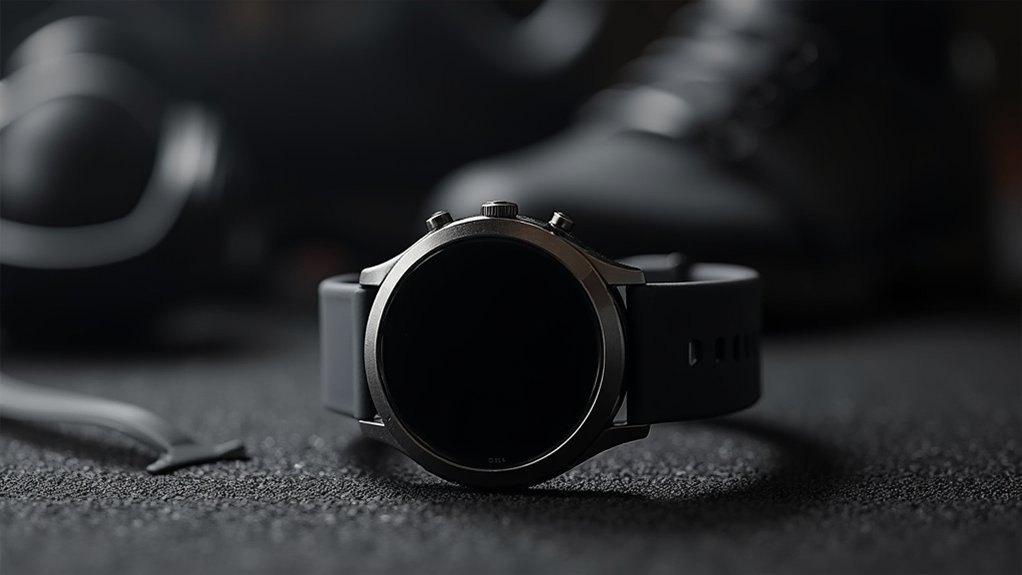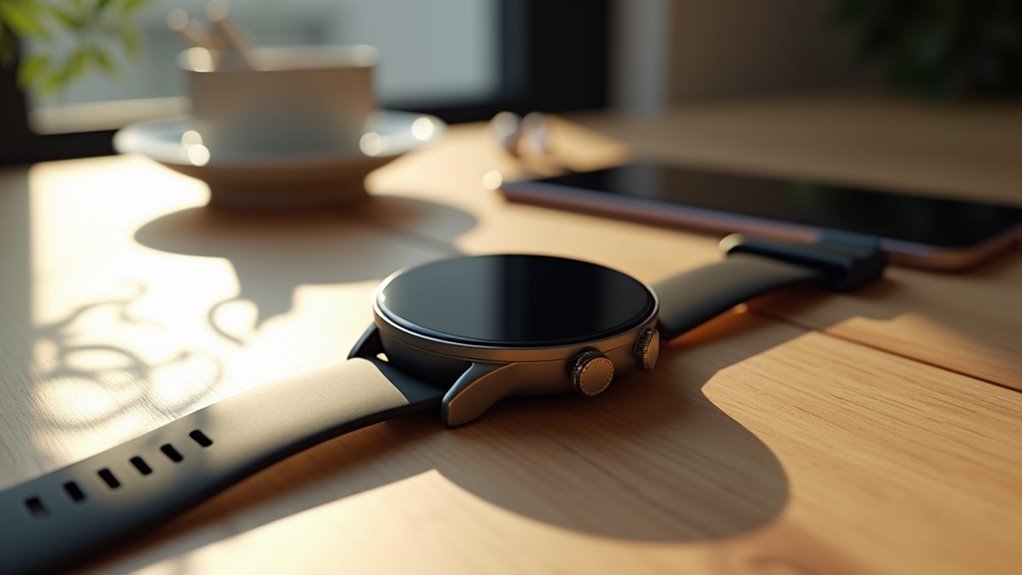You’ll find seven standout custom OS options for sports watches: Garmin OS offers advanced multisport analytics with five distinct profiles and automatic conversion tracking, while AsteroidOS provides fully open-source Linux customization with 48-hour battery life. Zepp OS delivers lightweight performance with extended battery, Fitbit OS excels at thorough health management, and FreeRTOS-based solutions guarantee real-time athletic data processing. Pebble OS prioritizes simplicity with 30-day battery life, and Tizen provides deep Samsung Health integration. Each option transforms your watch into a specialized athletic performance tool with unique advantages you’ll discover below.
Garmin OS – Advanced Multisport Analytics and Coaching Features

Five distinct multisport profiles on Garmin OS let you seamlessly track swimming, cycling, running, and shifts within a single workout session.
You’ll access pre-loaded triathlon setups and custom combinations like brick workouts, with automatic changeover time recording between disciplines. The system switches between sports manually or automatically during your sessions.
Garmin’s Elevate optical sensors deliver real-time heart rate data across all activities, while external HRM-Swim™ and HRM-Pro™ straps provide enhanced accuracy.
Real-time heart rate monitoring through built-in optical sensors, with premium chest strap compatibility for maximum precision during intense training sessions.
You’ll receive thorough session statistics during and after workouts, plus nightly HRV analysis for recovery insights. Transition times can be recorded separately from your main activity data to provide detailed performance breakdowns.
The adaptive Garmin Coach generates daily workout suggestions based on your fitness goals and recovery status.
You can customize interval timers for AMRAP, EMOM, and Tabata protocols while accessing dynamic routing for outdoor training sessions.
AsteroidOS – Open Source Alternative for Customizable Fitness Tracking
While mainstream sport watch operating systems lock you into proprietary ecosystems, AsteroidOS offers a completely open-source alternative that puts full control in your hands.
Built on Linux and licensed under GPLv2, you can modify and customize every aspect of this operating system. Unlike WearOS, you don’t need to pair with a phone—your watch operates independently with up to 48 hours of battery life.
You’ll find basic apps including timers, calculators, and weather forecasts, plus the ability to develop custom applications using Qt and QML.
While current GPS support isn’t fully implemented, you can connect external heart rate sensors and foot pods for sports tracking. The operating system utilizes libhybris to enable easy porting to existing Android and Wear OS watches.
The community-driven development encourages contributions, making it perfect for creating personalized fitness solutions without data collection concerns.
Zepp OS (Amazfit) – Lightweight Performance With Extended Battery Life

When you need a sport watch OS that prioritizes efficiency over complexity, Zepp OS delivers lightweight performance designed specifically for health-focused wearables.
You’ll find this system running on devices like the Amazfit Active 2 and T-Rex 3, providing real-time workout monitoring with extended battery life lasting several days. The operating system creates health value for users through its comprehensive health management capabilities.
The platform’s three key advantages include:
- Mini Programs and Custom Watch Faces – You can develop personalized applications and customize your watch interface through the lightweight development framework.
- Advanced Workout Extension Features – You’ll get real-time data monitoring during exercises with thorough sensor integration.
- Seamless Cross-Platform Integration – You can connect via Bluetooth 5.2 BLE to both Android and iOS devices through the Zepp App.
With API Level 4.0 support, you’ll access enhanced functionality while maintaining ideal performance efficiency.
Fitbit OS – Comprehensive Health Management and Activity Monitoring
You’ll find Fitbit OS excels at thorough health management through its extensive activity tracking features that monitor everything from steps and distance to GPS-based workouts and calorie burn.
The platform’s health dashboard integration seamlessly connects all your biometric data, including heart rate, SpO2, sleep patterns, and stress levels into one unified interface.
This integration allows you to access personalized insights and health trends directly from your wrist while maintaining synchronization with the broader Fitbit ecosystem. The system provides electrodermal activity graphs that enable comprehensive stress monitoring alongside mood logging capabilities for enhanced mindfulness management.
Activity Tracking Features
Fitbit OS transforms your sport watch into a thorough health companion that tracks every aspect of your fitness journey.
You’ll benefit from built-in GPS that delivers accurate pace and distance measurements without carrying your phone, while over 20 exercise modes cater to your specific workout preferences.
The extensive tracking system monitors your daily movements through:
- Real-time workout metrics – Heart rate zones, calorie burn, and effort levels display on your wrist during activities.
- Daily activity capture – Steps, distance, and calories tracked via 3-axis accelerometer sensors throughout each day.
- Extended data storage – Movement data retained for 7 days with daily totals stored for 30 days on-device.
You can set specific goals before workouts and receive alerts when you reach target zones or milestones, ensuring peak training effectiveness. The device provides Active Zone Minutes notifications that buzz when you reach target heart rate zones and earn extra minutes outside of structured exercise sessions.
Health Dashboard Integration
Beyond capturing your workout data, Fitbit OS consolidates all your health information into a centralized dashboard that transforms raw metrics into actionable insights. You’ll access thorough health monitoring through the Fitbit app’s Health Metrics dashboard, where breathing rate, heart rate variability, skin temperature, oxygen saturation, and resting heart rate are clearly displayed.
| Health Metric | Tracking Method | Device Compatibility | Data Period | Insights Provided |
|---|---|---|---|---|
| Breathing Rate | Sleep/rest monitoring | Sense, Versa 3, Charge 4 | 7-day trends | Respiratory health |
| Heart Rate Variability | Heartbeat variation analysis | Sense, Versa 2/3 | Real-time updates | Stress/recovery levels |
| Skin Temperature | Wrist temperature changes | Sense models | Continuous tracking | Illness detection |
| SpO2 Monitoring | Blood oxygen estimation | Inspire 2, Charge 4 | Sleep periods | Breathing issues |
| Resting Heart Rate | Cardiovascular assessment | All compatible devices | Daily averages | Fitness progression |
You can customize your dashboard layout and access deeper analytics with Premium subscriptions. The dashboard is now accessible in 18 languages to accommodate users worldwide, making comprehensive health tracking more inclusive for the global fitness community.
FreeRTOS-Based Solutions – Real-Time Performance for Athletic Applications

You’ll find FreeRTOS excels at managing multiple athletic functions simultaneously through its priority-based task scheduling system.
Your sport watch can process heart rate monitoring, GPS tracking, and step counting in real-time without delays that could compromise data accuracy.
This real-time performance guarantees you’re getting precise athletic metrics when every second counts during training or competition. Small microcontrollers running FreeRTOS deliver effective performance while maintaining the compact design essential for wearable devices.
Real-Time Task Scheduling
When developing a sport watch with stringent timing requirements, you’ll find that FreeRTOS provides a robust foundation for real-time task scheduling that’s essential for athletic applications.
The priority-based scheduler guarantees critical tasks like heart rate monitoring and GPS tracking get immediate CPU attention, while less urgent functions yield appropriately.
Your implementation should focus on three key scheduling strategies:
- Priority-Based Preemption – Assign highest priorities to sensor data collection and safety-critical functions.
- Task Synchronization – Use queues and semaphores to coordinate between display updates, BLE communication, and data processing.
- ISR Optimization – Keep interrupt handlers lightweight to minimize latency for button presses and sensor events.
You’ll need to balance responsiveness with power efficiency, guaranteeing your watch delivers consistent real-time performance throughout extended athletic activities. Consider implementing Rate Monotonic algorithms alongside traditional priority-based scheduling to optimize periodic tasks such as sensor sampling and display refreshes.
Athletic Data Processing
FreeRTOS transforms raw athletic data into actionable insights through its efficient processing architecture that handles multiple sensor inputs simultaneously.
You’ll benefit from its low-latency performance that guarantees immediate feedback during workouts, while GNSS integration provides precise location tracking for running and cycling activities. The system’s MEMS sensor support captures acceleration and rotation data efficiently, giving you thorough movement analysis.
You’ll appreciate how BLE protocol keeps your device discoverable while maintaining power efficiency through low-power modes.
The real-time processing capabilities handle time-critical applications without delay, assuring your performance metrics update instantly. FreeRTOS optimizes resource utilization on limited hardware, making it cost-effective for affordable sport watches while delivering responsive user experiences that enhance your training sessions. The customization options available in FreeRTOS allow brands to create unique interfaces specifically tailored for athletic performance monitoring.
Pebble OS – Minimalist Design With Long-Duration Sports Tracking
While mainstream smartwatches chase feature complexity, Pebble OS takes a deliberately different approach by prioritizing simplicity and endurance for serious athletes.
You’ll get up to 30 days of battery life through efficient e-paper displays and streamlined software that eliminates unnecessary features.
The OS delivers three key advantages for sports tracking:
- Always-on visibility – Your display stays readable during intense activities without draining battery
- No smartphone dependency – Core features work independently during long-duration events
- Interrupt-free experience – Minimalist interface won’t distract you from performance
You’ll access over 10,000 legacy apps and watchfaces while enjoying reliable notifications, fitness tracking, and music controls.
Physical buttons guarantee navigation works with gloves or wet hands, making this platform ideal for outdoor athletes who need dependable, long-lasting performance over flashy features. The platform maintains compatibility with both iPhone and Android devices, ensuring seamless integration regardless of your smartphone choice.
Tizen Legacy Sports Features – Samsung’s Athletic-Focused Implementation
Though Samsung discontinued Tizen OS for newer Galaxy Watch models, its legacy implementation remains one of the most thorough sport-focused platforms ever developed for wearables.
You’ll find deep Samsung Health integration that leverages multiple sensors—accelerometer, gyroscope, heart rate, and GPS—for extensive activity tracking. The OS automatically detects workouts when your movement matches predefined patterns, then displays real-time statistics during runs, swims, and cycling sessions.
You’re equipped with sport-specific routines, personalized coaching suggestions, and continuous heart rate monitoring with abnormal reading alerts.
The platform excels in durability with 5ATM waterproofing and MIL-STD-810G certification. You can customize watch faces with sport-focused widgets while enjoying seamless ecosystem integration including SmartThings, Samsung Pay, and offline music storage for uninterrupted athletic performance. The Knox Security framework also protects your sensitive fitness data and payment information stored on the device.
Frequently Asked Questions
Can I Install Multiple Custom OS on the Same Smartwatch Device?
You can’t install multiple custom OSes on most smartwatches due to limited storage, proprietary firmware restrictions, and locked bootloaders. Only specialized dual-chipset devices like OnePlus Watch 2 support multiple operating systems natively.
Which Custom OS Work With Both Android and Iphone Smartphones?
You’ll find Wear OS is your best option for cross-platform compatibility, working with both Android and iPhone smartphones through Google’s app, though iOS integration remains more limited than native WatchOS.
Do Custom OS Void My Smartwatch Warranty When Installed?
Installing custom OS typically voids manufacturer warranties, but EU statutory warranty remains valid unless software directly caused hardware failure. You’ll need to restore original firmware before warranty claims or face potential denial of service.
How Do I Backup My Original OS Before Installing Alternatives?
You’ll use your watch’s native backup feature through its settings menu or companion app like Galaxy Wearable. Access backup options, select data types, initiate the process, and confirm completion before installing alternatives.
Are Custom OS Updates Available as Frequently as Proprietary Versions?
Custom OS updates aren’t as frequent as proprietary versions since they’re community-driven with volunteer developers and limited resources. You’ll get more customization control, but you’ll wait longer between updates.
In Summary
You’ve got seven solid custom OS options that’ll transform your sport watch experience. Whether you’re seeking Garmin’s advanced analytics, AsteroidOS’s open-source flexibility, or Zepp’s impressive battery life, there’s something that’ll match your athletic needs. Don’t overlook FreeRTOS solutions for real-time performance or Pebble’s minimalist approach for long training sessions. Choose the OS that aligns with your sport priorities and you’ll maximize your watch’s potential.





Leave a Reply